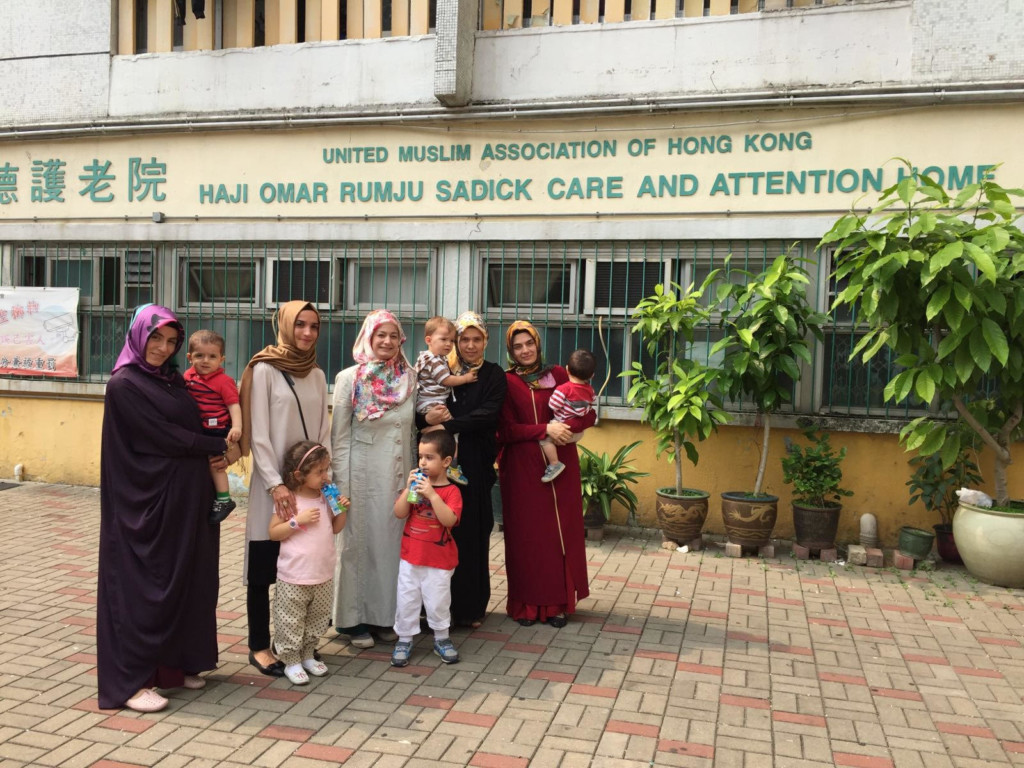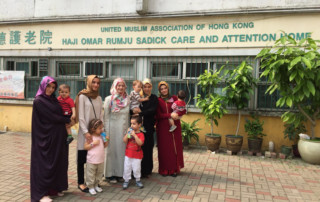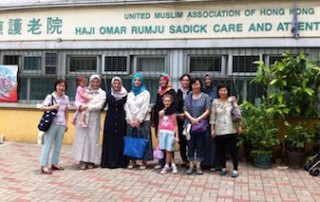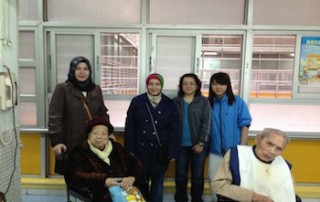Project Description
Visit to Elderly Home by PI Women
Posted on 2/6/2016
EVENT DETAILS
Pearl Institute Women visited Elderly Home to cure broken hearts and listen from them to make them happy.
In an article it said that the dramatic growth in the number of elderly people is one of the most remarkable features of industrial societies in this century. People are living longer and enjoying an increased expectation of life. In Britain since 1900 the percentage of the population over retirement age has gone up from around 6% to over 17%. This is mainly due to medical advances which have virtually eliminated infectious diseases as a cause of death. The general provision of secure food and water supplies and better sanitation, together with improved environmental conditions at home and at work, have also contributed a great deal.
Despite the improvements, increased age, in general, coincides with an increased incidence of both mental and physical illness. This is made worse by a weakening of social contacts and a reduction of income. Thus increasing age is also characterized by a dramatic increase in the use of health and social services. The older the person, the more likely he or she is to be admitted to hospital and the longer the stay.
The increasing demands on the hospital service have not been met by an increase in the total number of hospital beds. Medical and surgical treatments previously thought to require a three- or four-week stay in hospital are treated within a week or ten days. Also more work is now undertaken in the outpatient department on a day-care basis without overnight stay. Many medical cases previously requiring hospital care are now dealt with by the family doctor with the patient at home.
The whole concept of care has changed dramatically in recent years, and this has affected the caring approach in hospitals, residential homes and in the community. In the past, caring involved an active carer looking after a passive patient. Although it seemed quite natural to look after the sick and disabled in this way, the process produced too much dependence of the patient or client on the carer. The modern approach in health and social services is a process of enabling. Carers enable patients (or clients) to do as much as they can for themselves. This approach reduces dependence and keeps down the total level of care required.
The idea is that illness is best treated at home, if possible. The new legislation on community care, which took effect on the 1st April 1993, is based on this principle. Pain is a burden on oneself, and being removed from home and family to the strange environment of a hospital ward adds to the stress. This is especially so for the very young and the very old.
However, not all homes are the most satisfactory places in which to be ill. Many lack the basic amenities of hot and cold water, indoor lavatory, and satisfactory heating. Also there may be no relative or friend to do the caring,-to prepare food, ensure and maintain good standards of hygiene, and to offer companionship. Often the problems can be overcome to a certain extent by the use of voluntary help from religious groups and the agencies of the Health Service and local authority (e.g. community nurses, home helps, and ‘meals on wheels’).
At present only about 6% of all elderly people are in institutional care of some sort (hospitals, residential homes, and private nursing homes). Even this small percentage imposes very heavy burdens on these institutions; present resources are simply not enough to meet even a small increase in numbers. There are waiting lists for most institutions caring for the elderly.
A further 12% of the elderly are enabled to manage in their own homes, with the help of the care agencies already mentioned. The new community care programme strongly encourages such help in the home. Only a reduction in the proportion of very old people in the total population and a healthier elderly population would result in some easing of the problem.
Care on a self help / family / neighbourhood basis backed up by the provisions of the health and social services appears to deliver good results. When husbands, wives, brothers, sisters, friends and neighbours, are involved together in the process of caring for the elderly, a very good sense of community develops. Children in particular have a special responsibility towards their parents.
Community Care, Values and Welfare State
A. Bilir
A welfare state is a state that cares for its most needy citizens such as the elderly, the sick and disabled, children, the unemployed and single parents. The term ‘welfare state’ implies that the state has assumed responsibility for the welfare of its citizens and for the solution of its main social problems. Its principal aim is to improve individual and general welfare at the minimum cost.
The quality of the services provided by the welfare state depends upon its level of prosperity. For this reason, welfare states came into existence in industrialised countries before developing countries. Where these states have been economically and politically stable, improvements in social welfare have been made. However, there has been a claim that in recent years the concept of the welfare state is in crisis and that in practice governments have been unable to meet the needs of vulnerable people adequately. Welfare pluralists have claimed that the welfare state has failed to meet needs and provide services. They assert that the state must withdraw from direct provision and recognise the potential of both the family -especially in providing personal social services, and the voluntary sector. With the provision of services transferred from the state to the community, the cost of social services will become less and effectiveness will increase. However, will ‘the community’ shoulder this responsibility? Can the family be expected to meet the needs as effectively as welfare pluralists envisage. There are serious doubts whether a well formed family structure neighbourhood actually exists.
‘The community’ is now seen as the main source of care for vulnerable people. ‘Community care’ implies ordinary members of local communities such as families, neighbours and friends providing help and care for those who are in need.
Abrams (1977) defines community care as the provision of help, support and protection by lay members of societies acting in everyday domestic and occupational settings. It is possible to say that community care is care provided by the community itself.
The community is composed of families, neighbours and friends. Most of the care for the elderly and for children is provided by families and relatives. Only a limited number of elderly people, children or the disabled are cared for by the statutory voluntary organizations; the rest are looked after by their families and relatives and to a limited extent by neighbours and friends. In the United Kingdom during 1987 fewer than 243,000 out of a total of 8,6 million people aged 65 and over were resident in local authorities’, voluntary organizations’ and the private sectors’ homes. This means that only nearly 3,5% of the total number of elderly people were living in institutional homes: The rest of them were either taken care of by their families or were trying to cope with living on their own.
If the burden of social services provision is to be shouldered by the community, can families, relatives or neighbours manage to act as a realistic substitute for the welfare state? Can they meet the expectations of the welfare pluralists?
In today’s industrial societies most relationships are based on reciprocal interests. Individualism is at its highest level. The ties of kinship and family are withering away. Social and moral values are being undermined. However, as Abrams (1977) points out, the effective social bases for community care are kinship, religion and race, not ‘the community’.
Although the family is seen as the strongest and most reliable source of care, it is at present undergoing severe problems, particularly in Western societies. The family is affected by a number of social and demographic factors, the most significant ones being: the age structure of population, its marital structure, the size of the family and the changing roles of the family members (Nissel: 1980).
The population is ageing. The number of elderly in need is increasing and the level of provision is decreasing. On the one hand number of the people dependant on family care is increasing and is likely to continue increasing; on the other, the number of carers is declining because the idea of having a family is disappearing and the size of the family is getting smaller. Birth rates decreased from 84,3% in 1971 to 64,2% in 1990 in the United Kingdom and the percentage of births outside marriage rose from 8,1% in 1971 to 30,3% in 1990 (Social Trends, 22:1992). This may mean that there will be fewer potential carers when the present generation of parents reach old age (Johnson: 1990). The family is also faced with a changing marital structure. There are increasing numbers of one-parent families caused by separation, divorce and deaths. Many of these single parents have young children. Divorce affects the care negatively; the estimated number of divorcees in Great Britain was about 517,000 in 1971 and increasing to 2,374,000 in 1988 (Social Trends, 20:1990).
Another set of demographic and social factors that affect the relation between the family and the welfare state is the change in household structure. It would be argued that women are more likely than men to be the carers of the family. This is because women have been seen traditionally as the main people responsible for the care of children and the elderly, while the men have been seen as the bread-winners working outside of the home for the family. However, during the last two decades this situation has changed in Western societies. Although most of the family-based care is shouldered by women, the number of women in the labour force has been increasing. According to the statistics, there were 9,3 million women in the British labour force in 1971 and to 11,8 million in 1988. It is also projected that there will be 12,7 million women working in the year 2000 (Social Trends, 20:1990). The number of working women is likely to continue increasing, and as a result this may mean that the care provided by women is likely to decline.
In today’s world, particularly, in Western industrialized societies, the family has gradually been losing its strength and increasingly unable to perform its functions. It may be true to say that we now live in a world where family, social and moral values are being slowly destroyed. Policy makers, politicians and religious scholars are worried about what should be done to avoid the impending consequences.
How can men and women be encouraged to stay in marriage? How can their children be motivated to care for their frail parents? What are the motivations that keep the society in order and ensure that its members help each other? How is altruism managed in societies where individualism exists? How can social solidarity be re-established? There are many other questions; however, most agree that the main problem is with the social and moral values of society.
In recent years, the managers of the welfare state have found it difficult to meet the needs of its ever increasing number of vulnerable people due to high costs, ineffectiveness and lack of resources. This has led them to try to shun all responsibility for provision of services and to put the onus on us ‘the community’.
However, as society as a whole changes, relationships between children and parents, between families, between neighbours are changing. People’s behaviour in a society is usually formed by their social position and by the moral and religious beliefs with which they have been brought up. It may be impossible to expect people to take care of others especially those who are in need, if they do not feel that they should do so. In today’s societies it is clear that most of the elderly parents are not looked after by their children and they have to cope with living on their own which they usually cannot manage. Most neighbours are also reluctant to get to know each other.
We can conclude that societies need to be supported by strong social and moral values which form the norms of social behaviour. Only then people will try to behave as they are expected to as human beings. In this context, I will leave you with the words of the Messenger, upon him be peace:
‘None of you truly believes until he wishes for his brother what he wishes for himself’, ‘He who does not care about his neighbour’s starvation, while he is in wealth, is not among us’, and ‘He who desires that he be granted more provision and his lease of life be prolonged, should treat his kith and kin well’.
References:
ABRAMS P. (1977) Community Care: Some Research Problems and Priorities Policy and Politics No.6
JOHNSON N. (1990) Reconstructing the Welfare State Hertfordshire: Simon&Schuster Int.
NISSEL M. et al. (1980) The Welfare State-Diversity&Decentralisation, London, PSI
Social Trends 20 (1990) London Central Statistic Office
Social Trends 22 (1992) London Central Statistic Office
SPICKER P. (1988) Principles of Social Welfare, London, Routledge
WALKER A. et al. (1986) The Debate About Community, London PSI
Invalid Displayed Gallery
The views and opinions expressed on this posts/pages are those of the authors and do not necessarily reflect the views or opinions of Pearl Institute, its staff, other authors, members, partners, or sponsors.




















Leave A Comment